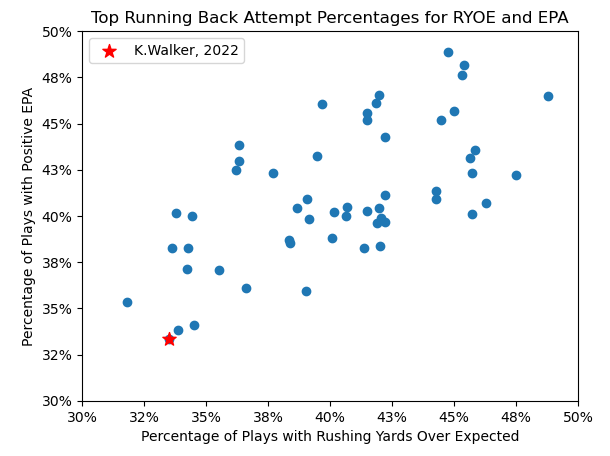Are You There God? It’s Me, a Kenneth Walker Owner
The Underlying Data Behind Walker’s Season and Why the Seahawks Called for Reinforcements
Life was so, so good for Kenneth Walker owners, until late afternoon on April 28th, 2023. The Seahawks star put up a 1,000 yard season in his rookie campaign, taking on a workhorse role from Week 6 of 2022 after a season-ending injury for Rashaad Penny. Shouts of “League Winner!” flooded the interwebs, as Walker produced immediately, with RB 2, 3, and 8 finishes (0.5 PPR) amongst his first four starts.
On the dynasty side, Walker jumped to RB7 on KeepTradeCut after Penny’s injury. Within a month, Walker stood on top of the peak as RB1. Before the NFL Draft, Walker’s value settled at RB4, with only an as-of-yet undrafted Bijan Robinson, Breece Hall, and Jonathan Taylor ahead of him. A workhorse running-back heading into his second year on an ascending offense? Life was so, so good. However, something sinister was in store.
The Seattle Seahawks threw a spanner in the works, drafting UCLA’s Zach Charbonnet with the 52nd pick of the 2023 NFL Draft. Suddenly, the values of two promising young running backs were in jeopardy. For all the talks of Pete Carroll wanting a run-first approach, could the two co-exist in a manner conducive to fantasy football? Surely the move capped the ceilings of both?
I will leave projecting the two for another day – today, I want to understand why the Seahawks spent premium draft capital on competition for Walker, despite a seemingly strong start to his career. And if no answer is to come from above, well, maybe we will have more luck exploring the underlying metrics beneath Walker’s season.
Hypothesis, Analysis, and Findings
The hypothesis proposed by some was that Walker, for all his strengths, was inconsistent from down-to-down. He displayed the ability to break off home runs, but his overall play negatively impacted the Seahawks. His season tally was propped up by a small percentage of big runs, and he was wildly ineffective with his scoring opportunities. As a result, Seattle brought in a bruising running back, with the profile to churn out tough yardage when needed to keep drives alive, and the ability to punch in routine touchdowns efficiently.
For this analysis, I used the nfl_data_py Python library prepared by cooperdff to access NFL play-by-play and “Next Gen Stat” data. These datasets featured two metrics that could provide insight into the hypothesis: Rushing Yards Over Expected (RYOE) and Expected Points Added (EPA).
Rushing Yards Over Expected is the difference between actual rushing yards and expected rushing yards on an individual play or series of plays.
Expected Points Added is a measure of success which defines the value of each play by the effect it has on the offense’s likelihood of scoring.
These stats highlight the efficiency and efficacy of a player. RYOE highlights the player’s ability to produce, and EPA conveys how their performance affects the team. In 2022, Walker exceeded his expected rush yards by 117, or at a rate of +0.51 RYOE per attempt. The table below features running backs that gained 1,000+ rushing yards in 2022:

However, Walker’s accumulated EPA for the regular season was -14.8. In other words, Walker’s rush attempts lost the Seahawks two touchdowns over the season. Despite this, Walker’s EPA doesn’t mark him out as an overtly poor performer, when compared to the same group:

With names like Saquon Barkley and Derrick Henry below Walker, along with Jamaal Williams who scored 17 rushing touchdowns, Walker’s full-season EPA doesn’t immediately throw up major red flags. We know that Barkley and Henry are elite running backs. I think this is a product of running plays on average gaining only a little yardage, theoretically setting teams behind where they need to be to score a touchdown on a drive.
Love our content? Check out the GoingFor2 Live Podcast Network!
To focus my analysis on Walker’s consistency, I decided to look at the percentage of plays with positive outcomes in both metrics. To begin, I isolated my dataset to look at running backs that accumulated 1,000+ yards in the last five seasons. This gave me a sample of 54 running back seasons, with the following historical averages for these “top RBs”:

Here’s where things started to go south for Walker – he ranked second last in the percentage of attempts with positive RYOE, and dead last in the percentage of attempts with positive EPA:

Oof. Walker exceeded expected rushing yards on only 33.4% of his attempts, and he added positive expected points on only 33.3% of these plays. Walker severely underperformed his “top RB” peers at historic levels in these metrics, adding credence to the hypothesis of his inconsistency. Only Leonard Fournette in his 2019 season hit a lower mark in either of these regards (31.8% +RYOE attempts).
In essence, Walker failed to generate positive outcomes on a repeated, down-to-down basis. With this in mind, you can see why Carroll opted to bring in a bigger back to churn out the yardage that each down requires for the game state. To take this need for consistency further, let’s look at Walker’s performance in scoring situations:

Walker scored 9 rushing touchdowns in his rookie campaign, but only 2 came from within the 5-yard line, despite having 10 attempts from this range. His 20% conversion rate was a far cry from the league-wide success rate of 40.7% on rushing touchdowns from attempts within the 5. The last three entries in the table above encapsulate his struggle, as he had three consecutive attempts within the 2 in Week 18, but did not come away with a touchdown. Again, it is easy to conclude why the Seahawks needed a back in Charbonnet’s mold. Converting routine touchdowns is essential for winning football games, and a larger back should have more success in powering in from that range.
Amidst these harsh truths, we shouldn’t forget that Walker is an electric back, and one of the best big-play threats in the entire league. The capability for home-run plays put Walker on the map almost immediately after taking the starting role:
Walker was elite at breakaway runs (20+ yards), with only Nick Chubb racking up more than Walker’s 10 in the entire NFL, and only Justin Fields gaining more yardage on such runs. Amongst the 1,000+ yard running backs, only Tony Pollard had a higher breakaway run percentage. However, this exploration confirmed the final part of the hypothesis proposed earlier – these breakaway runs masked the weaknesses in Walker’s game. Walker generated 35% of his season’s yardage on just 10 breakaway runs. His season’s tally was predominantly fueled by these big plays, whereas the average for other top RBs was 19.7% of season yardage from breakaway plays.
In conclusion, Kenneth Walker was inconsistent on the ground in his rookie campaign. He generated positive plays in terms of RYOE and EPA at historically low rates, and he was horrendously inefficient at punching in touchdowns on the goal line. He flashed genuine ability as a big-play threat, placing himself amongst the best in the NFL in this regard. But his performance was too reliant on these rarer plays, and Walker did not do enough from down-to-down to be considered an untouchable running back.
Unfortunately for Walker owners, we know how the Seahawks are attempting to remedy these issues in their running game, bringing in a big, bruising runner in Zach Charbonnet. Even if Walker continues to lead the backfield, we will see Charbonnet sap away attempts; worryingly, the new rookie on the block will command high-value touches, in goal-line attempts and targets. The two-headed monster will benefit the Seahawks immensely, improving their ability to prolong drives, score touchdowns, and win games. But for Walker managers, we should rightfully be worried about the ceiling of the short-lived dynasty RB1.
ATTN Dynasty Commissioners: Do you want to do something cool for your league? How about a 1-hour live show dedicated to YOUR league? Team-by-team breakdowns, rankings, and more. For details and to book a show, visit: GoingFor2.com/plp.






